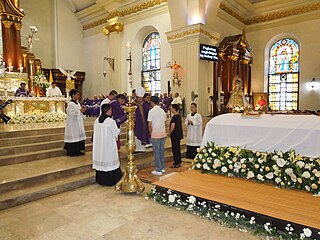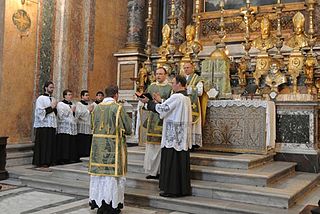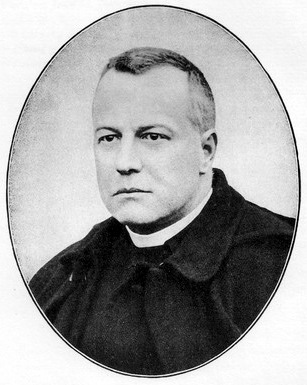Related Research Articles

Mass is the main Eucharistic liturgical service in many forms of Western Christianity. The term Mass is commonly used in the Catholic Church, Western Rite Orthodoxy, Old Catholicism, and Independent Catholicism. The term is used in some Lutheran churches, as well as in some Anglican churches. The term is also used, on rare occasion, by other Protestant churches.

The Mass of Paul VI, also known as the Ordinary Form or Novus Ordo, is the most commonly used liturgy in the Catholic Church. It is a form of the Latin Church's Roman Rite, and was promulgated by Pope Paul VI in 1969 and published by him in 1970; it was then revised in the 1975 edition of the Roman Missal, further revised by Pope John Paul II in 2000, and published in a third edition in 2002.

The Tridentine Mass, also known as the Traditional Latin Mass or the Traditional Rite, is the liturgy in the Roman Missal of the Catholic Church published from 1570 to 1962. Celebrated almost exclusively in Ecclesiastical Latin, it was the most widely used Eucharistic liturgy in the world from its issuance in 1570 until the introduction of the Mass of Paul VI.

A Requiem or Requiem Mass, also known as Mass for the dead or Mass of the dead, is a Mass of the Catholic Church offered for the repose of the soul or souls of one or more deceased persons, using a particular form of the Roman Missal. It is usually celebrated in the context of a funeral.

Low Mass is a Tridentine Mass defined officially in the Code of Rubrics included in the 1962 edition of the Roman Missal as a Mass in which the priest does not chant the parts that the rubrics assign to him. A sung Mass celebrated with the assistance of sacred ministers is a High or Solemn Mass; without them it is a Missa Cantata.

The offertory is the part of a Eucharistic service when the bread and wine for use in the service are ceremonially placed on the altar.
The Deutsche Singmesse is a form of (Tridentine) Low Mass that developed in German-speaking countries.
A Dialogue Mass is a Low Mass wherein the people recite some parts of the Latin Tridentine Mass.

The Roman Rite is the most common ritual family for performing the ecclesiastical services of the Latin Church, the largest of the sui iuris particular churches that comprise the Catholic Church. The Roman Rite governs rites such as the Roman Mass and the Liturgy of the Hours as well as the manner in which sacraments and blessings are performed.
Missa cantata is a form of Tridentine Mass defined officially in 1960 as a sung Mass celebrated without sacred ministers, i.e., deacon and subdeacon.

Solemn Mass is the full ceremonial form of a Mass, predominantly associated with the Tridentine Mass where it is celebrated by a priest with a deacon and a subdeacon, requiring most of the parts of the Mass to be sung, and the use of incense. It is also called High Mass or Solemn High Mass.
The Canon of the Mass, also known as the Canon of the Roman Mass and in the Mass of Paul VI as the Roman Canon or Eucharistic Prayer I, is the oldest anaphora used in the Roman Rite of Mass. The name Canon Missæ was used in the Tridentine Missal from the first typical edition of Pope Pius V in 1570 to that of Pope John XXIII in 1962 to describe the part of the Mass of the Roman Rite that began after the Sanctus with the words Te igitur. All editions preceding that of 1962 place the indication "Canon Missae" at the head of each page from that point until the end of the Mass; that of 1962 does so only until the page preceding the Pater Noster and places the heading "Ordo Missae" on the following pages.
The Roman Canon is the oldest eucharistic prayer used in the Mass of the Roman Rite, and dates its arrangement to at least the 7th century; its core, however, is much older. Through the centuries, the Roman Canon has undergone minor alterations and modifications, but retains the same essential form it took in the seventh century under Pope Gregory I. Before 1970, it was the only eucharistic prayer used in the Roman Missal, but since then three other eucharistic prayers were newly composed for the Mass of Paul VI.
The text and rubrics of the Roman Canon have undergone revisions over the centuries, while the canon itself has retained its essential form as arranged no later than the 7th century. The text consists of a succession of short prayers with no clear sequence of thought. The rubrics, as is customary in similar liturgical books, indicate the manner in which to carry out the celebration.

Ite, missa est are the concluding Latin words addressed to the people in the Mass of the Roman Rite, as well as the Lutheran Divine Service. Until the reforms of 1962, at Masses without the Gloria, Benedicamus Domino was said instead. The response of the people is Deo gratias.

The Mass is the central liturgical service of the Eucharist in the Catholic Church, in which bread and wine are consecrated and become the body and blood of Christ. As defined by the Church at the Council of Trent, in the Mass "the same Christ who offered himself once in a bloody manner on the altar of the cross, is present and offered in an unbloody manner". The Church describes the Mass as the "source and summit of the Christian life", and teaches that the Mass is a sacrifice, in which the sacramental bread and wine, through consecration by an ordained priest, become the sacrificial body, blood, soul, and divinity of Christ as the sacrifice on Calvary made truly present once again on the altar. The Catholic Church permits only baptised members in the state of grace to receive Christ in the Eucharist.
The Missa sicca was a form of Catholic devotion used in the medieval Catholic Church when a full Mass could not be said, such as for funerals or marriages which were served in the afternoon after a priest had already said Mass earlier that morning. It consisted of all components the Mass except the Offertory, Consecration and Communion.

Adrian Henry Timothy Knottesford Fortescue was an English Catholic priest and polymath. An influential liturgist, artist, calligrapher, composer, polyglot, amateur photographer, Byzantine scholar, and adventurer, he was also the founder of the Church of St Hugh of Lincoln in Letchworth.
A Catholic funeral is carried out in accordance with the prescribed rites of the Catholic Church. Such funerals are referred to in Catholic canon law as "ecclesiastical funerals" and are dealt with in canons 1176–1185 of the 1983 Code of Canon Law, and in canons 874–879 of the Code of Canons of the Eastern Churches. In Catholic funerals, the Church "seeks spiritual support for the deceased, honors their bodies, and at the same time brings the solace of hope to the living." The Second Vatican Council in its Constitution on the Liturgy decreed: "The rite for the burial of the dead should express more clearly the paschal character of Christian death, and should correspond more closely to the circumstances and traditions found in various regions."
In the liturgy of the Catholic Church, a votive Mass is a Mass offered for a votum, a special intention. Such a Mass does not correspond to the Divine Office for the day on which it is celebrated. Every day in the year has appointed to it a series of canonical hours and a Mass corresponding, containing, for instance, the same collect and the same Gospel. On most days, the Mass will correspond to the Office, but on occasion, other Masses may be celebrated. Votive Masses appear in the Roman and Gallican Rites.
References
- 1 2 3 4 Fortescue, Adrian (1950). The Mass. Рипол Классик. p. 193. ISBN 9785872948124.
- ↑ Jungmann, Joseph. The Mass of the Roman Rite: Its Origins and Development (Missarum Sollemnia) . Translated by Brunner, Francis.
- 1 2 Hart, Richard (1846). Ecclesiastical Records of England, Ireland, and Scotland, from the Fifth Century till the Reformation: being an epitome of British Councils, the Legatine and Provincial Constitutions, and other Memorials of the olden time, with Prolegomena and Notes (2nd ed.). p. 178.
The Missa Bifaciata, or Trifaciata, in which, that he might gain several stipends for one sacrifice, the priest recited the service over and over again as far as the offertory, and concluded with one 'Canon'
- ↑
 Fortescue, Adrian (1910). "Liturgy of the Mass". In Herbermann, Charles (ed.). Catholic Encyclopedia . Vol. 9. New York: Robert Appleton Company. Retrieved 14 February 2019.
Fortescue, Adrian (1910). "Liturgy of the Mass". In Herbermann, Charles (ed.). Catholic Encyclopedia . Vol. 9. New York: Robert Appleton Company. Retrieved 14 February 2019. - ↑ Durand, Guillaume (1280). Rationale divinorum officiorum. Vol. IV.